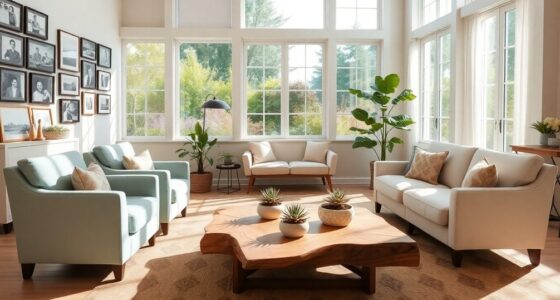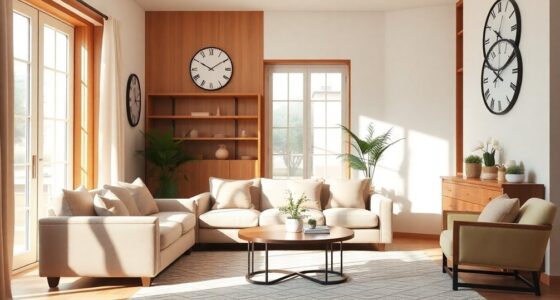You won't believe how easy it is to transform senior homes with clever design hacks! Start by ensuring consistent flooring levels to prevent tripping hazards. Widen doorways for wheelchair accessibility and utilize non-slip materials in kitchens and bathrooms. Arrange furniture thoughtfully to maintain clear pathways and customize countertop heights for better functionality. Add personal touches with decor and low-maintenance plants for comfort. Keep going to discover even more innovative ideas that make senior living enjoyable and safe!
Key Takeaways
- Widen doorways to at least 36 inches and install lever-style handles for improved wheelchair accessibility and ease of use.
- Use non-slip rugs and solid surface flooring to minimize tripping hazards and enhance safety in senior living spaces.
- Incorporate lazy susans and pull-out shelves in kitchens for better visibility and accessibility of frequently used items.
- Arrange furniture to create clear pathways of at least 36 inches, promoting easier navigation and reducing clutter.
- Add personal touches like meaningful artwork and low-maintenance plants to enhance emotional well-being and create a welcoming environment.
Ensure Consistent Flooring Levels for Safety
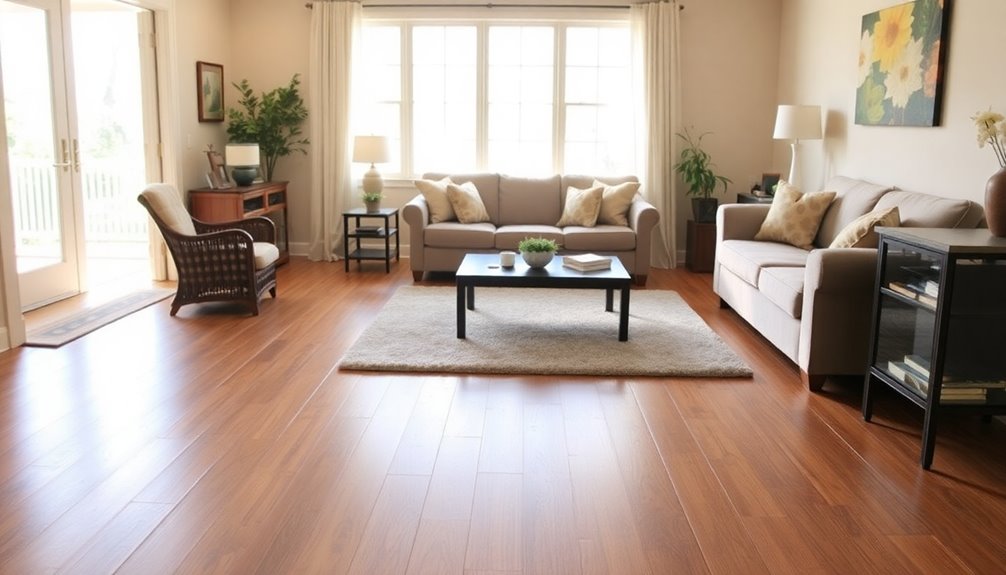
When designing a senior home, guaranteeing consistent flooring levels is essential for safety. Changes between different flooring types can create tripping hazards, greatly increasing the risk of falls, especially for those with mobility issues.
By maintaining the same level across all flooring materials, you eliminate these dangers and provide a smoother navigation path. Solid surface flooring, such as hardwood or laminate, is particularly beneficial, as it's easier for mobility aids to traverse compared to thick carpets that can impede movement.
If your home has elevated foundations, consider installing ramps to guarantee smooth changes between levels. Regular assessments of flooring can also help identify potential hazards, allowing you to maintain a safe living environment and reduce the risk of accidents.
Widen Doorways for Enhanced Accessibility
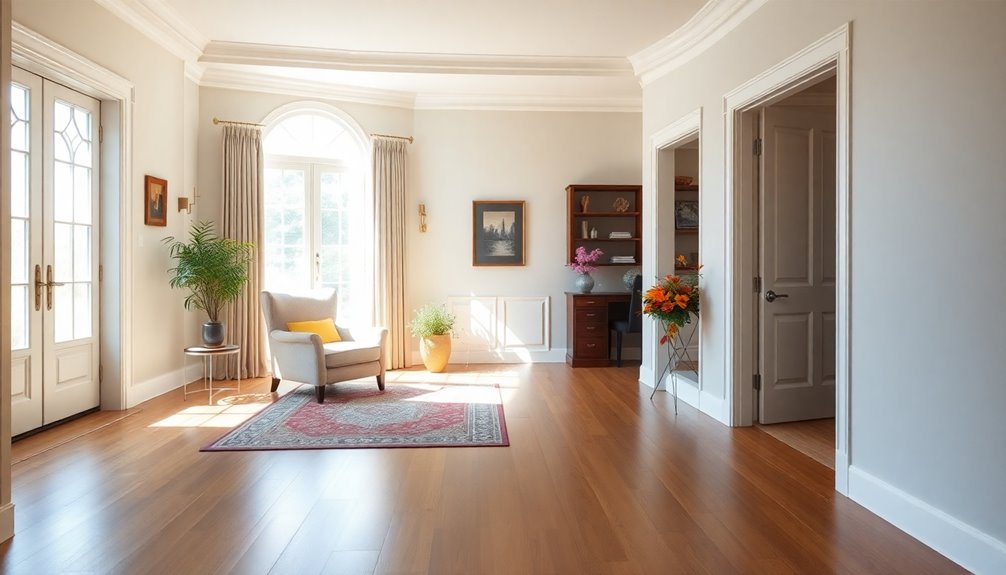
Consistent flooring levels set the stage for a safe environment, but widening doorways takes accessibility to the next level.
To enhance mobility within your home, consider widening doorways to at least 36 inches, as recommended by ADA regulations. This modification guarantees wheelchair access and makes navigation much easier for those with mobility challenges.
Keep doorways free of obstructions to reduce discomfort and the risk of accidents. Wider doorways not only improve accessibility but also create a more open, spacious feel in your home.
You might also want to install lever-style door handles instead of traditional knobs, as they're easier to operate for individuals with limited hand strength.
Finally, plan for clear pathways around furniture to further facilitate movement and safety.
Utilize Non-Slip Materials in Bathrooms and Kitchens

Falls are a major concern in senior homes, particularly in bathrooms and kitchens where wet surfaces increase the risk of injury.
To enhance safety, consider utilizing non-slip materials. Here are some effective strategies to reduce the risk:
- Install non-slip tiles or vinyl flooring: These provide better traction than traditional surfaces.
- Add non-slip mats or strips: Place them in shower areas and near sinks for extra grip.
- Choose materials with a high coefficient of friction: Look for ratings above 0.6 to guarantee safety.
- Maintain surfaces regularly: Clean to remove soap scum and grease, keeping non-slip materials effective.
- Regular cleaning supports a healthier lifestyle: Keeping surfaces clean not only enhances safety but also promotes a healthier lifestyle by reducing potential hazards associated with dirt and grime.
Thoughtful Furniture Placement for Clear Pathways

When arranging furniture, it's essential to maximize open spaces for easy navigation.
Make sure you consider mobility needs by allowing at least 36 inches of clear pathways for those using walkers or wheelchairs. Thoughtful placement not only enhances safety but also creates a welcoming environment for social interactions. Additionally, creating a clutter-free environment can significantly reduce the impact of falls on seniors, promoting greater independence and confidence. Furthermore, incorporating accessible design principles can further enhance the functionality of a space, ensuring that it caters to the diverse needs of seniors. Incorporating elements that provide social interaction can also contribute to overall well-being and happiness in senior living environments.
Maximize Open Spaces
To create a welcoming and safe environment for seniors, thoughtful furniture placement is key in maximizing open spaces.
Here are some tips to help you enhance accessibility and safety:
- Guarantee pathways are at least 36 inches wide for easy navigation.
- Arrange furniture to create distinct zones, avoiding clutter that can confuse or obstruct movement.
- Use rounded furniture edges to reduce the risk of injury in tight areas.
- Keep frequently used items at waist level to minimize bending or stretching.
Additionally, incorporating natural elements into your decor can promote tranquility and enhance the overall ambiance of the space. User consent management ensures that seniors and their families can feel secure about how their data is handled when engaging with smart home technologies. Creating a well-designed home can significantly improve the quality of life for seniors, making it easier for them to engage with their environment.
Consider Mobility Needs
Creating a safe and accessible environment goes beyond maximizing open spaces; it's also about considering mobility needs in furniture placement. Guarantee pathways are at least 36 inches wide, allowing easy navigation for wheelchairs. Avoid crowding furniture, as this can lead to obstacles and increase fall risks. Opt for lower sofas and chairs to help with sitting and standing. Creating "landing zones" for safe pauses during movement is essential, especially as care needs evolve over time. Choose rounded-edge furniture to minimize injury risks. Incorporating functional design elements can further enhance the overall safety and usability of the space. Additionally, implementing energy-efficient HVAC systems can contribute to a comfortable living environment by maintaining consistent temperatures year-round.
| Tip | Description | Benefit |
|---|---|---|
| Clear Pathways | Maintain 36 inches width | Enhances mobility needs |
| Avoid Clutter | Keep furniture spaced apart | Reduces fall risks |
| Low Furniture | Use accessible seating options | Increases quality of life |
| Landing Zones | Designate safe areas for rest | Supports mobility changes |
| Soft Edges | Choose rounded furniture | Enhances safety in home |
Customize Countertop Heights for Functionality

Customizing countertop heights is essential for ensuring seniors can navigate their kitchens safely and comfortably.
It's important to find the right height to accommodate different mobility needs. Here are four tips to help you achieve this:
- Measure Individual Heights: Tailor countertops to the specific needs of the user for maximum comfort.
- Set Countertop Heights: For wheelchair users, aim for 28-32 inches to allow easy access.
- Adjust Faucet Placement: Install faucets lower to prevent straining when reaching for them.
- Incorporate Floating Countertops: These can enhance accessibility and aesthetics, provided they're designed thoughtfully.
Incorporate Grab Bars for Daily Activities
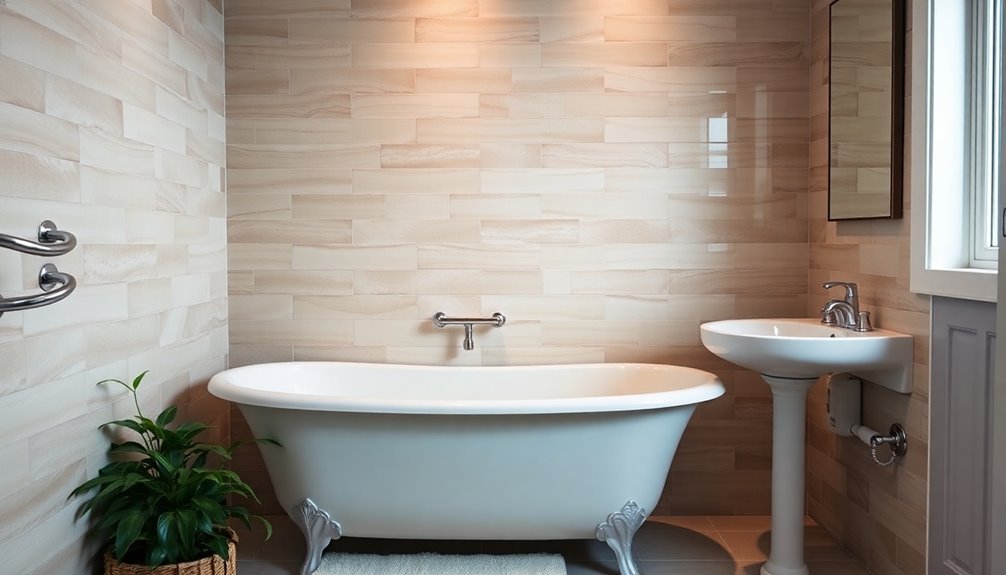
Incorporating grab bars in senior homes can dramatically enhance safety and independence during daily activities. Installing these essential features in bathrooms and hallways greatly reduces the risk of falls, a leading cause of injury among seniors.
Aim to securely anchor grab bars at a height of 33 to 36 inches for ideal support while transferring in and out of showers or tubs. Choose grab bars with a textured surface to guarantee a better grip, especially when wet.
Don't forget to take into account aesthetics—select styles and finishes that blend with the room's design. Finally, regularly check the stability of grab bars, as wear and tear can compromise their effectiveness, particularly in high-use areas like bathrooms.
Create Distinct Spaces With Strategic Furniture Arrangement

- Zone Activities: Use strategic placement to create areas for reading, dining, or relaxing.
- Light and Bold Colors: Choose light colors for living areas to promote openness, and bold colors for bathrooms to add visual interest.
- Incorporate Dividers: Use bookcases or decorative screens to create physical separations without compromising light.
- Cohesive Decor: Maintain a cohesive theme across rooms so that distinct spaces feel interconnected.
- Maximize Comfort: Consider comfortable seating options to enhance relaxation and promote social interaction.
These simple adjustments can dramatically improve both the aesthetic and usability of your home!
Use Rugs to Create Cohesion and Define Areas

Rugs serve as powerful tools in interior design, especially in senior homes, where they can define spaces and enhance overall cohesion. By placing rugs in various areas, you create distinct zones for activities like lounging, dining, or reading. This helps maximize space utilization and makes the home feel more organized.
Opt for light-colored rugs in living areas to brighten the space, while bold colors can define bathrooms. Choose rugs made from non-slip materials to minimize tripping hazards, ensuring safety for seniors with mobility challenges.
Additionally, incorporating rugs with different textures can add depth and interest, providing tactile stimulation that encourages cognitive engagement. With these simple changes, you can transform your senior home into a harmonious and inviting environment.
Maximize Storage Solutions in Closets and Kitchens

Creating a harmonious environment in senior homes goes beyond defining spaces with rugs; it also involves effective storage solutions that enhance functionality.
To maximize storage in closets and kitchens, consider these tips:
- Outfit closets with shelving and hanging organizers to optimize vertical space, making items easily accessible.
- Store shoes in clear bags or boxes to simplify access and minimize clutter.
- Utilize under-shelf baskets in kitchen cabinets for additional storage of spices or smaller items.
- Invest in lazy susans or pull-out shelves to improve visibility and accessibility of frequently used items.
Adding functional layouts can further enhance the organization of these spaces, ensuring seniors can navigate their homes with ease.
Add Personal Touches With Decor and Plants

To create a cozy and inviting space, think about incorporating meaningful artwork and family photos that resonate with you. Adding low-maintenance plants can't only brighten your home but also improve air quality. Additionally, consider using decor that reflects eco-friendly materials to create a more sustainable living space. Incorporating natural materials like wood can also enhance the warmth and character of your home. You might also explore adding features like a heated mattress pad to enhance your comfort during colder months. These personal touches can make your environment feel more like home and enhance your overall well-being.
Incorporate Meaningful Artwork
Incorporating meaningful artwork and personal touches like decor and plants can transform a senior home into a warm and inviting space.
For older adults, this approach enhances emotional well-being and encourages social interaction. Here are some ideas to get started:
- Display family photos: Create a gallery wall that showcases cherished moments.
- Use artwork by loved ones: Personal creations can spark joy and nostalgia.
- Choose a cohesive color scheme: Unify the space with colors that evoke positive emotions.
- Incorporate art that tells a story: Select pieces that resonate with personal experiences or memories.
Additionally, consider using natural materials like wood and stone in your decor to create a comforting and tranquil environment.
These thoughtful touches not only beautify the environment but also foster a sense of purpose and belonging in one's living space.
Select Low-Maintenance Plants
While selecting low-maintenance plants can seem challenging, it's easier than you think to enhance your senior home with greenery that thrives on minimal care.
Consider adding succulents or snake plants, which improve indoor air quality and require little attention. They flourish in indirect light and only need occasional watering, perfect for your energy levels in senior living.
Vibrant options like pothos or peace lilies can bring color and tranquility, boosting your emotional well-being.
Use decorative pots and plant stands to showcase your style without the hassle. Grouping plants together creates a mini indoor garden, providing visual appeal and easy upkeep.
If you're unsure, don't hesitate to seek professional help for choosing the right plants for your space.
Personalize With Family Photos
Nothing brings warmth and familiarity to a senior home quite like personal touches, and family photos are a perfect way to achieve that.
By incorporating images of your family members, you can enhance emotional well-being and create a sense of belonging.
Here are four ways to personalize your space:
- Create a Gallery Wall: Use various frames to display cherished memories, sparking conversation with guests.
- Mix Sizes and Styles: Combine different frame sizes and styles for visual interest.
- Add Plants: Incorporate greenery to beautify your space and improve air quality.
- Rotate Photos: Change out photos seasonally to keep the decor fresh and exciting.
These simple additions can transform your home into a comforting sanctuary.
Frequently Asked Questions
What Is the 70/30 Rule in Interior Design?
The 70/30 rule in interior design suggests that you should allocate 70% of your space to functional elements, while the remaining 30% focuses on decorative aspects.
This balance guarantees your environment is practical and accessible, especially for seniors. By prioritizing functionality, you can create wide pathways and accessible storage while still allowing for personal style.
Using versatile furnishings also helps maximize smaller spaces, enhancing both beauty and ease of navigation in your home.
What Is the 60/40 Rule in Interior Design?
Imagine baking a cake where you use 60% flour and 40% sugar; that balance creates a delicious treat.
The 60/40 rule in interior design works similarly. It suggests that 60% of your space should feature dominant elements like primary colors or larger furniture, while 40% includes accents that complement these features.
This approach creates harmony and draws attention to focal points, making your space feel inviting and organized.
It's a recipe for success in any room!
What Are the 7 Basics of Interior Design?
The seven basics of interior design are vital for creating a harmonious space.
Start by understanding space, which defines the flow and usability of your design.
Next, consider lines, as they guide the eye and influence perception.
Light plays an essential role in mood, so prioritize natural sources.
Color affects emotions, while texture adds depth.
Finally, patterns can introduce visual interest.
How to Interior Design an Old House?
When you're interior designing an old house, focus on preserving its historical charm while adding modern comforts.
Use light colors and large mirrors to brighten the space and create an inviting atmosphere.
Update flooring to solid surfaces for easier navigation, and guarantee smooth changes to prevent trips.
Define functional areas with strategic furniture placement and area rugs.
Finally, incorporate accessible storage solutions to enhance usability without sacrificing the home's character.
Conclusion
By implementing these clever interior design hacks, you can create a safe, functional, and inviting space for seniors. Remember, "Home is where the heart is," so let's make sure it's a place where they feel comfortable and at ease. With thoughtful adjustments, you can enhance accessibility and promote independence, ensuring that your loved ones can enjoy their golden years in a space that truly reflects their needs and personality.



